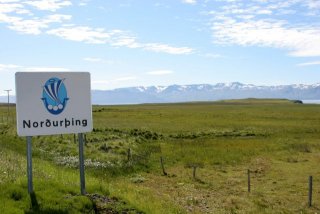Alcoa still plans to build an aluminium smelter in Bakki by Húsavík, north-Iceland, according to the newspaper Fréttablaðið. This contradicts recent news, published in the business newspaper Viðskiptablaðið, saying that Alcoa was about to withdraw the idea due to the government’s alleged unwillingness to go ahead with it. Questions about energy to run the smelter are still unanswered but recent comments from the National Planning Agency, concerning the project’s joint Environmental Impact Assessment (EIA), state that enough geothermal energy can not be produced for the smelter; and certainly not in a sustainable way.
A delegation committee from Alcoa, including John Thurstadt, the head of the company’s aluminium production worldwide, and Marcos Ramos, president of Alcoa in Europe, were in Iceland over the weekend to meet with the government and Landsvirkjun, Iceland’s national energy company. During the meetings, the committee stated that Alcoa is not withdrawing from the project and wants to go ahead with the project.
Less then three weeks ago, on January 20th, business newspaper Viðskiptablaðið, stated that Alcoa would soon announce the company’s withdrawal. The reason, according to the paper, was the obstacles that the current government has put in the way of the project, reaching its climax in September 2009 when Katrín Júlíusdóttir, Minister of Industry, refused to renew a memorandum of understanding between Alcoa, the council of Húsavík and the government at that time. The memorandum was originally signed in March 2006 and had repeatedly been renewed as the speed of the project slowed down. By refusing to renew it, Júlíusdóttir did however not rule out the smelter but most significantly disagreed with Alcoa about its planned size.
After this weekend’s meetings, Tómas Már Sigurðsson, CEO of Alcoa in Iceland, said in the media that the company’s has not changed at all and that the government had sent good messages about the future of the project. Asked about the frequently asked questions about the energy that the smelter is supposed to be run on, Sigurðasson said that he believed there is enough energy for the project: “A permit exists for more then 500 MW of power plants on the north-east corner [of Iceland].”
In the summer of 2008, Þórunn Sveinbjarnardóttir, Minister of Environment at that time, ruled that a joint Environmental Impact Assessment (EIA) had to be made, including the planned smelter, geothermal power plants and energy transportation. Whereas the decision was met with anger by the smelters proponents – some of them calling it a trick to actually stop the smelter from being built – others critisized the minister for not including in the EIA, possible hydro dams in several rivers in north Iceland that would be needed to produce enough energy to run a smelter of this size: at least 346 thousand tons per year (tpy) but maybe even 500 tpy according to the words of Alcoa’s Vice-President Bernt Reitan.
In an article published in the newspaper Morgunblaðið in August 2008, Jaap Krater, an ecological economist and a spokesperson of Saving Iceland, stated:
“A 250,000 ton smelter would require 400 MW of electricity. The energy would be coming from the geothermal fields in North Iceland. If the optimistic estimate of 370 MW for Krafla 2 (drilling into the Viti volcano), Þeistareykir and Bjarnarflag would be realised, which is uncertain, there would still be a deficiency, so 30 MW would be taken from the yet unspoiled and unexplored Gjástykki area, at a huge environmental cost . For a medium sized smelter the deficiency would rise to at least 150 MW and for a large smelter it would be at least 400 MW.”
“Thus, if the Bakki project is pushed through, it is almost inevitable that this will lead to construction of more large dams.”
The joint EIA was published in 2010 and in November that same year the National Planning Agency published its comment on the report. The agency’s conclusion was damning and proved three key points of Saving Iceland’s critique: Firstly, the environmental impacts of the drilling in the north will be far more then claimed by Alcoa. Secondly, not enough geothermal energy can be harnessed in the north to run the smelter. Thirdly, the project will highly increase Iceland’s emissions of greenhouse-gases and constitute 14% of the country’s total emission (which is already high above international agreements).
The questions about how Alcoa and Landsvirkjun are going to get enough energy for the smelter and if new dams have to be built, where they will be located, have still not been answered. Both parties are allowed to boldly talk about the project without being faced with these fundamental questions, which were highlighted in a press release from Saving Iceland on November 25th 2010 but ignored by the media, apart from the Reykjavik Grapevine, who’s report can be read here.

And what about the greenhouse gas emissions from the dams? It’s time for those to be taken into account!
Björn,
here are some articles on the issue:
https://www.savingiceland.org/2007/09/glacial-rivers-reduce-pollution-on-earth-by-gudmundur-pall-olafsson/
https://www.savingiceland.org/2007/08/hydropower-disaster-for-global-warming-by-jaap-krater/
https://www.savingiceland.org/2007/08/hydroelectric-powers-dirty-secret-revealed/